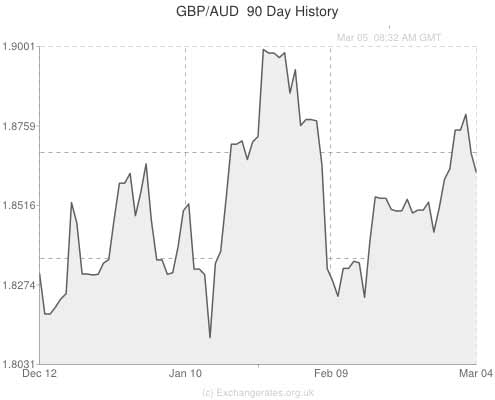
Sterling sunk by around half a cent from 1.8610 to 1.8560 earlier this morning in reaction to a better-than-expected Australian GDP report. The Australian Bureau of Statistics announced that economic growth accelerated by 0.8% during the fourth quarter, beating expectations of 0.7%. The annual GDP print came in at 2.8%, compared to forecasts of 2.5%.
The robust data print sent Sterling to a weekly low against the ‘Aussie’ Dollar as investors recalibrated their estimations of the Australian economy.
Tuesday trading
The Pound to Australian Dollar exchange rate (GBP/AUD) started the day well yesterday as traders sold the ‘Aussie’ in a knee-jerk reaction to the Reserve Bank of Australia’s latest policy statement.
The RBA maintained its record low benchmark interest rate of 2.50%, as was widely anticipated beforehand, but Glenn Steven’s accompanying press conference saw the Governor bemoan the high value of the domestic currency and this negatively impacted the Australian Dollar.
Stevens noted:
“The decline in the exchange rate seen to date will assist in achieving balanced growth in the economy [but] the Dollar remains high by historical standards”.
However, Sterling was unable to hold onto its gains as traders digested the rest of Stevens’ comments, which suggested that rates would not be reduced again in the foreseeable future:
“On present indications, the most prudent course is likely to be a period of stability in interest rates”.
GBP/AUD remained relatively flat during the London session as UK Construction printed underwhelmingly at 62.6, down from a 6-year high of 64.6. The PMI report suggested that the inclement weather had impacted housebuilding, but that civil engineering projects accelerated at their fastest rate since 1997 as local authorities attempted to repair damages from the floods and storms. With job creation at a 3-year high, it is entirely likely that British Construction output will fight back in March; this positive underlying message prevented investors from selling Sterling too harshly on the back of the PMI report.
Developments in the Ukrainian/Russian crisis helped boost risk sentiment following the major selloff on Monday; Russian President Vladimir Putin said that he will wage war with Ukraine and his attempts to soothe the crisis went down well with financial markets. The US Dollar declined mildly and demand for the high-risk ‘Aussie’ and ‘Kiwi’ Dollars improved slightly as risk aversion trends softened.

Comments are closed.